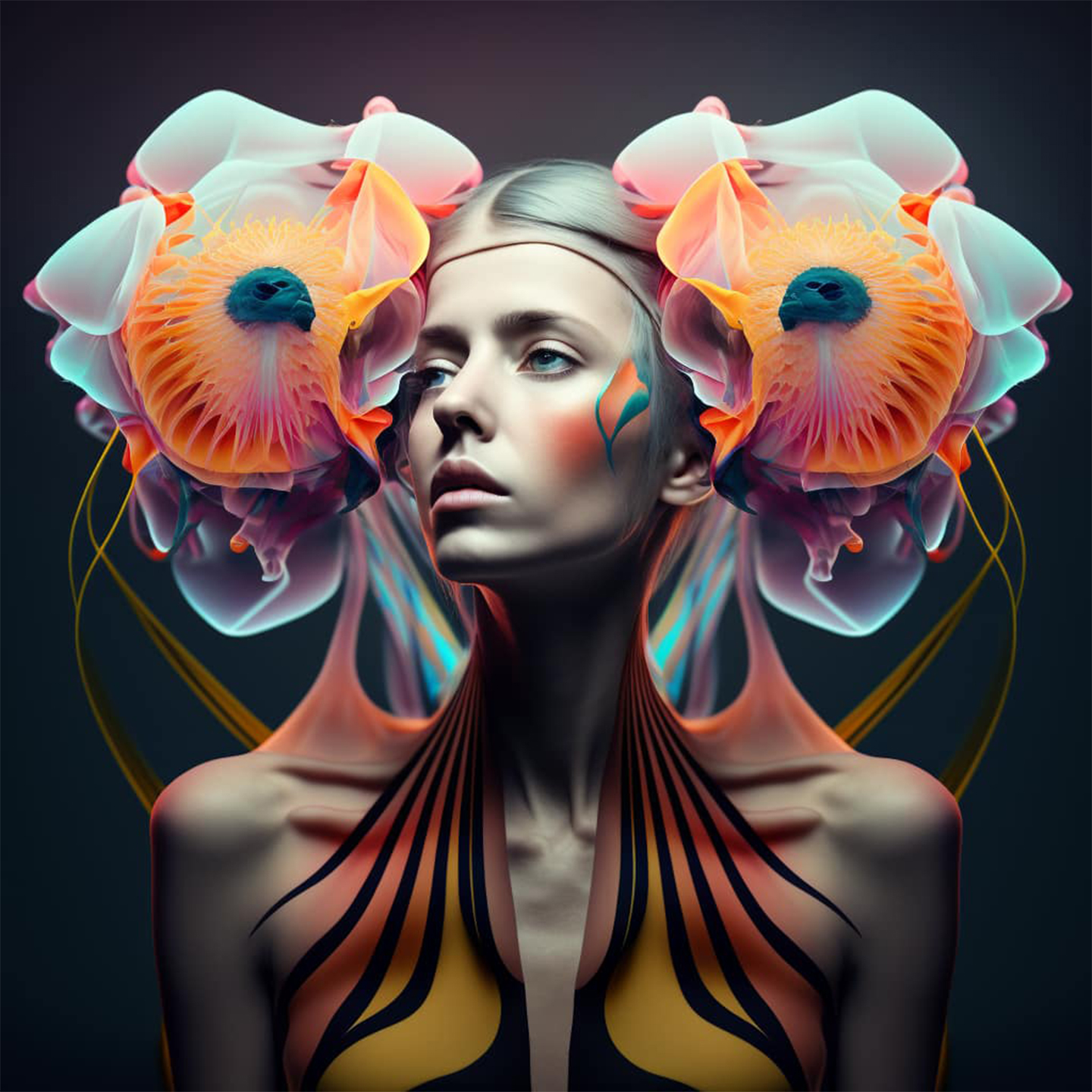Necklaces that defy gravity. Impossible sleeves. Asymmetrical eyeglasses. Unwearable fabrics. Eye soring patterns. And athleisure garments inspired by reptile skin that have an actual iguana embedded in the garment. What’s not to like?
Visualizza questo post su Instagram
Jokes aside, hallucinations are one of the biggest flaws of generative AI tools today, and we can expect it will be fixed in the future. The latest versions of OpenAI and Stable Diffusion AI tools have already reduce the risk of hallucination.

An image crafted with Midjourney emerges from numerous combinations of women and corals. While the 'blend' feature merges two visuals, the resulting outcomes frequently navigate into visionary and surreal realms, straying significantly from the initial prompt. Courtesy of the author
Nonetheless, artists and professionals in the creative fields still use earlier, rudimentary versions, such as the amazing visionary Midjourney v3, to generate artwork because the result is pleasantly unpredictable, less realistic and way more dreamlike than with the newest releases.
Riding the hype of AI-generated nonsense
Fashion designers are challenging themselves with AI-generated inspirations, but only a few of them are actually making sense of the hype and admitting it.
Collina Strada is one of the first fashion brands to translate AI-fuelled designs into IRL items and showcase them at New York Fashion Week. The founder, Hillary Taymour, believes that generative AI is a game changer for the fashion industry and also credits the creative contributions made by hallucinations to the design process.
Visualizza questo post su Instagram
Taymour’s sentiment about the impact of generative AI is supported by data: according to McKinsey, generative AI could add up to 275 billion dollars to the fashion and luxury market.
One drawback of using AI tools, however, is that it can affect creativity negatively. According to research by the Boston Consulting Group on value and Generative AI, even when these tools are used properly, the very meaning of creativity is at stake. In fact, there is a fundamental difference between generating ideas and creating them.
“Because GPT-4 provides responses with very similar meaning time and again to the same sorts of prompts, the output (...) was individually better but collectively repetitive”. The researcher named this effect “The Creativity Trap”, pointing out that for creative purposes, there is a trade-off between individual benefits and a huge loss for the community of creatives.
How to challenge (and beat) predictability
If you ask Midjourney to create variations on Monna Lisa and transform her into a Lego character, you can expect a very predictable result. It’s because the Leonardo Da Vinci Masterpiece and Lego brand are icons.
Plato, more than two thousand years ago, used the allegory of the Cave to explain this concept: text-to-image AI tools start generating the shadows of things and then complete and refine them into something more detailed. The final product is influenced by a sort of polarised attraction, similar to magnetic sand, which guides the result towards what was initially expected.
Try asking for something more specific, like a very niche Korean fashion brand matched with the style of an emerging photographer, and you will achieve unimaginable results, whether they are good or bad. All you need is the courage to take a leap of faith and some spare time to experiment.
Latency, stereotypes and other lovely bugs
Many flaws other than hallucinating can be turned into a strength for creative purposes:
- Latency. There is an unintentional persistence of some details in AI-generated visuals when created in series or after intensive training. If you use the same prompt with different seeds and slight variations in Midjourney (or similar), you may notice elements of one prompt blended into another, even after hours or days since you ran the original prompt.
Visualizza questo post su Instagram
-
Stereotypes. Try soliciting clichés from the machine on purpose. I have generated an amazing and totally unexpected necklace inspired by the traditional neckrings of Kayan women by running the “African woman” prompt instead of “black woman”. My main goal was to give my female character darker skin and some somatic features of African women, but Midjourney reacted by adding a jewel. It took me off guard, but I liked it and saved it in my favourite seeds.
- Plagiarism. The human mind is capable of recalling the general shape of an Alexander McQueen outfit from its long-term memory archive. However, if you have never seen one, you just can’t. Similarly, Generative AI can add some derivative attributes to the “shadows” (to quote Plato) of the designer’s style. Starting from this point, you can create some amazing collaborations by blending the unique styles of iconic designers with your own designs.
-
Randomness. Let AI have fun with your text input without restraining it too much. Chaos is one of the default Midjourney parameters that allow you to lose control of your prompting and achieve unpredictable visuals.
Gaia Giordani
Generative AI explorer and New Media Communication expert



